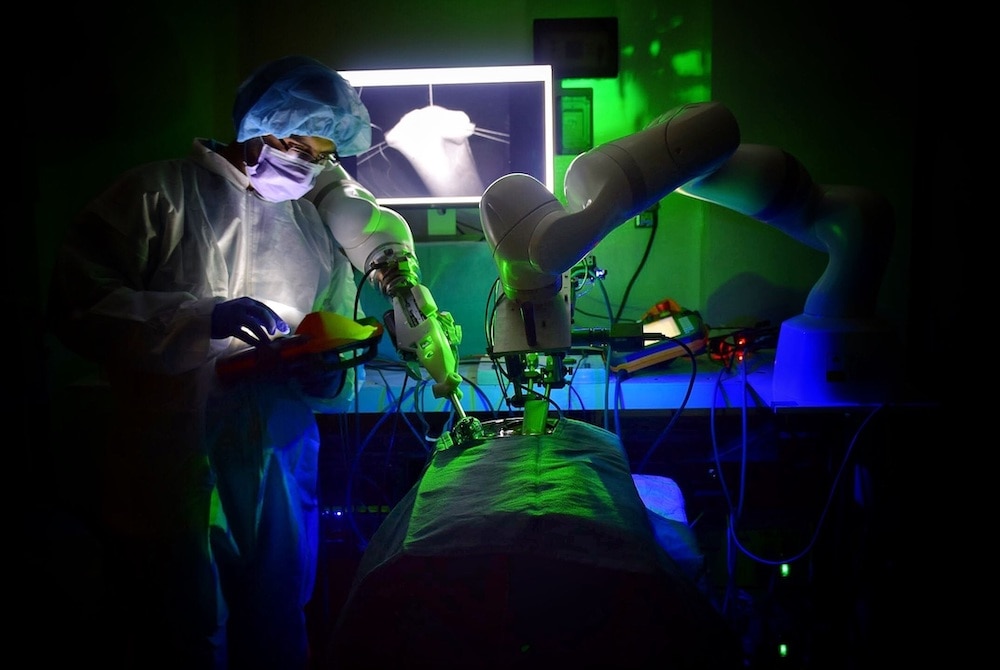Create a free profile to get unlimited access to exclusive videos, sweepstakes, and more!
Unassisted robotic surgery means the robots are coming and they have scalpels
They don't want to kill you, they just want to take out your appendix.

Surgery is difficult and complicated even under ideal circumstances. There’s a reason you have to train so long to become a surgeon. Then there are times when the body conspires to ratchet the difficulty up a few notches. Maybe the area that needs operating is incredibly small or needs a hand more delicate than human surgeons are capable of offering. Maybe the operation is going to be tens of hours long and there’s a danger that fatigue will set in. In these scenarios, it can be useful to call upon the help of a robot.
Today, there are a few types of commercial robots used in surgical procedures. The CyberKnife is specialized for working on tumors; there’s the ROBODOC surgical system intended for operations involving bones; and then there’s da Vinci which operates on soft tissues.
Operating on soft tissue is notoriously difficult for robots because of the way tissues will deform and change shape once cut. The da Vinci system gets around this by enlisting a human surgeon to operate the controls via a pair of joysticks. Developing a robotic system capable of completing soft tissue operations without the direct involvement of a human controller is the ultimate aim of medical engineering and scientists at Johns Hopkins University may have just crossed a major threshold.
Justin Opfermann is a mechanical engineer at Johns Hopkins who, along with colleagues, just completed the first unassisted robotic soft tissue operation in an animal using their Smart Tissue Autonomous Robot (STAR). The results were published in the journal Science Robotics.
“What's different with this robot is it uses a level of autonomy to do the surgery. Instead of a human using joysticks to move the robot, it looks at the surgical scene, creates a surgical plan, and carries out that plan by itself. It doesn’t need a human to direct where it’s going and what it needs to do,” Opfermann told SYFY WIRE.
Opfermann and the team developed a new surgical camera which allows STAR to look at the target tissues and identify key structures to build a geometric map of the surgical field. That camera builds the map in three dimensions, something which is important regardless of the surgery you’re doing, but is especially important when working with some soft tissues like intestines which might need sutures along a tubular surface.
By continuously taking pictures in real-time, the robot is able to know when the state of the field changes and make adjustments to its plan to compensate. The continuously updated surgical field map is the key innovation which allows STAR to operate on soft tissues without human guidance.
“If you’re doing a bone surgery, you can take a picture beforehand and know it’s not going to change. It’s rigid, it’s not going to move. With soft tissue, as soon as you cut it, it opens. It collapses, the structure changes. So, you really need a system that’s constantly watching and updating the plan,” Opfermann said.
STAR keeps an eye on the key points it identifies up front to watch for movement. If they fall out of a certain threshold a flag gets sent to the robot which tells it to stop and reassess before proceeding. It’s unlikely, however, that robots will be operating on humans without supervision any time soon. Even with a system like STAR, which is capable of recognizing changes, there are too many variations even between two patients undergoing the same procedure.
“Having a robot do the entire procedure is the dream, but there’s definitely going to be a lot of small steps along the way before we get there,” Opfermann said. “We’ll have smaller autonomous tasks that get chained together and eventually you’ll have a full system.”
For now, the team is working toward having human surgeons continue doing the things they’re best at while letting robots take over in areas where they excel. One area where a system like STAR would excel is closing up at the end of a long surgery. Suturing is a repetitive motion. That’s the sort of thing robots are really good at, and they often come at the end of a long surgery when surgeons might be tired.
It’s likely we’ll start to see systems like STAR operating under a shared control paradigm wherein a surgeon controls the system for much of the procedure and then flips a switch when they reach parts of the operation wherein autonomous control will be beneficial.
“Having a robot that doesn’t get tired and can make consistent decisions and execute with higher precision and accuracy, we think is the benefit of bringing this to the surgical field.” Opfermann said.
The surgery completed by the team serves as a proof of concept that the system works, but there’s still a lot of steps to complete and hoops to jump through before it’s ready for a hospital setting. Right now, the system can’t be sterilized to the standards required for human operations. That’s an engineering challenge the team is tackling. There are also FDA approvals in the works but still pending.
The future of surgical medicine is coming, and it’s shiny.


























